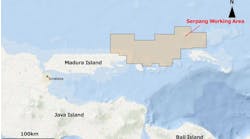Nick Terdre
Contributing Editor
The achievement of first oil from the Peregrino heavy-oil field in Brazil in April marked a major milestone for Statoil, the operator. It is the first field to be brought onstream by the company in Brazil and its largest operated field outside Norway. And by bringing Peregrino's 14ºAPI crude to the surface, Statoil provided convincing testimony of its heavy oil expertise.
The Peregrino layout: Two wellhead platforms tied back to an FPSO. (Image courtesy of Statoil)
Lying in a water depth of 100-120 m (330 to 390 ft) in the Campos basin, some 85 km (53 mi) from shore, Peregrino was developed with two wellhead/drilling platforms which deliver production to an FPSO for processing and storage. First oil was achieved through a single well, but within a year production is due to ramp up to a peak of some 100,000 b/d.
The FPSO,Maersk Peregrino, is supplied and operated under a 15-year lease, with options for a further 15 years, by Maersk FPSOs. Converted from a newbuild VLCC tanker at the Keppel FELS yard in Singapore, it has 1.6 MMbbl storage capacity, production capacity of 100,000 b/d of oil and 7.3 MMcf/d of gas, and liquids-handling capacity of 350,000 b/d. The 15 modules which constitute the topsides weigh 12,500 metric tonnes (13,779 tons) and there is accommodation for 100 personnel. The topside process modules were delivered by J. Ray McDermott.
The vessel is moored to a submerged turret production system provided by APL, which is held in place by 10 chain-and-wire mooring lines attached to 90-metric tonne (99 ton) piles. The mooring was performed by Aker Marine Contractors.
The two wellhead platforms were constructed at Kiewit's Corpus Christi, Texas, yard. Each has a topsides of about 8,200 metric tonnes (9,039 tons) dry weight supported by a 6,700-metric tonne (7,385-ton) jacket. The platforms were installed by Heerema Marine Contractors' crane-bargeHermod. Operations, maintenance, and modification services are provided by Wood Group.
Each wellhead platform connects to the FPSO by two oil production pipelines and an injection water pipeline, while two power and signal cables also run from the FPSO to each platform. Pipelay and cable-lay was performed by Subsea 7.
In the first phase, 37 wells are planned, consisting of 30 horizontal producers and seven water injectors. With its rather unconsolidated sands and thin oil-bearing sections, the reservoir represents a challenge to drill, which is being done by Archer. But the achievements are already being recorded, including the longest horizontal open-hole gravel-packed section ever drilled in Brazil – 1,300 m (approx. 4,200 ft) – and future plans call for even longer sections
Electric submersible pumps are installed downhole in each production well to boost the wellstream flow to the surface. On arrival on the FPSO, the crude is heated to 130-150ºC to facilitate processing, and the stabilized oil is stored at 65-70ºC.
Next year, Statoil plans to start implementing IOR (increased oil recovery). The first of these is multi-lateral wells, which the company is familiar with due to its extensive use of them on the Norwegian continental shelf. However, the Peregrino multi-laterals will be the first such wells in Brazil.
Polymer flooding of the reservoir will also be implemented, to improve the effect of water sweep. This is a proven technique on onshore fields, and in 2010 Statoil ran a successful pilot on the Heidrun field in Norway. The third IOR measure is a smart tool known as the autonomous inflow control device (AICD), a version of which Statoil has patented. Installed as part of the well completion, the AICD is able to distinguish between high-viscosity heavy oil, which is allowed to pass into the well-bore, and low-viscosity water and gas, which is kept out.
Hydro bought into Peregrino in 2005; and then StatoilHydro, as the company came to be known, bought Anardarko's stake in 2008, becoming the sole licensee and operator.
By applying its heavy oil expertise, Statoil reckons it will achieve base-case recovery of 20% of the estimated 2.3MMbbl of in-place reserves, more or less double what previous owners were envisaging. Recoverable reserves are estimated at 300-600MMbbl. There are several reasons why it has not yet been possible to establish more exact estimates. The main reservoir which is being developed in the current phase extends over an area of 535 sq km. In the reservoir itself, the thickness and distribution of the sand bodies is uncertain, and some parts are below seismic resolution, so that reliable data will only become available when they are drilled.
Further development looks likely following the discovery of additional reserves. To a 2007 find on the Peregrino South-West prospect, Statoil in April added a promising strike with the Peregrino South exploration well, which discovered a gross 130-m (427-ft) oil column. Appraisal drilling will show if these are commercial.
Further potential has also been identified in the carbonate Macae formation of the main field, which does not form part of the present development. Statoil plans to carry out a long-term production test in the Macae to establish whether it should be brought into permanent production.
In 2010, Statoil took on a partner, Sinochem, to which it agreed to sell a 40% interest in the field for $3.1 billion. The deal was completed just after start-up.
Offshore Articles Archives
View Oil and Gas Articles on PennEnergy.com




